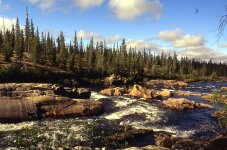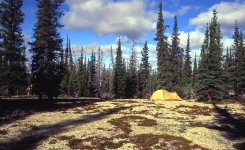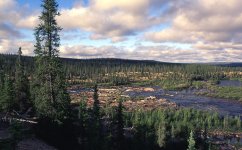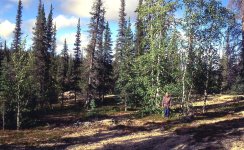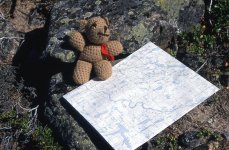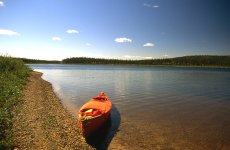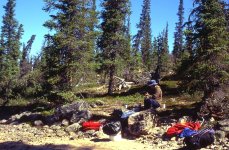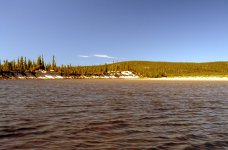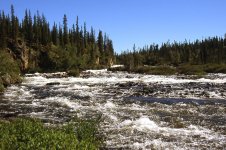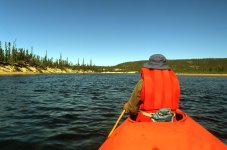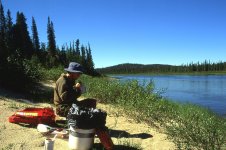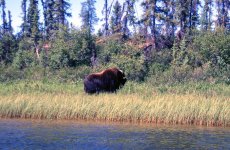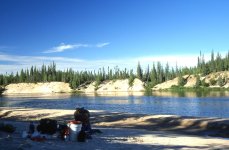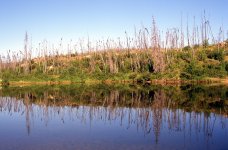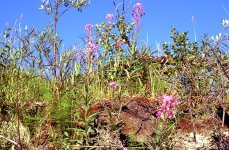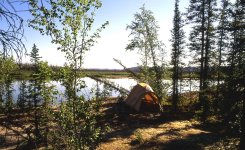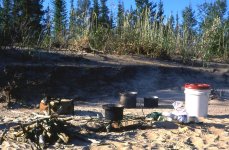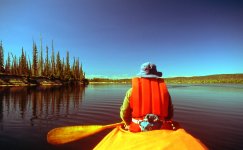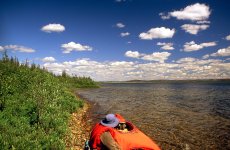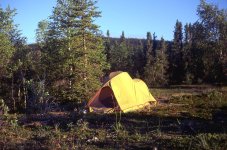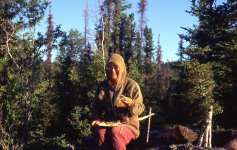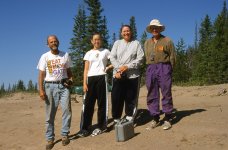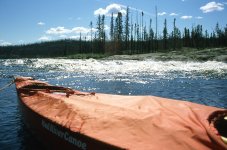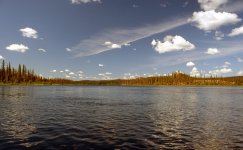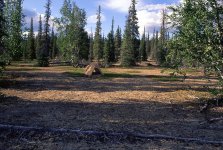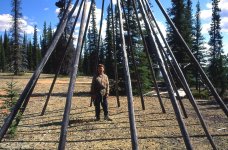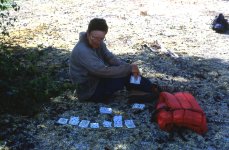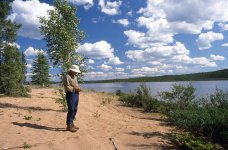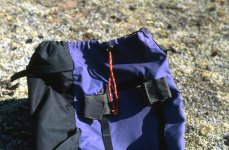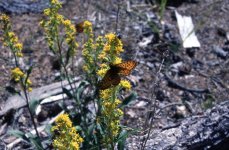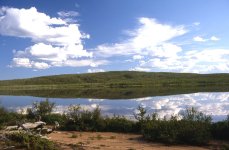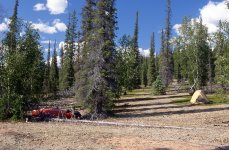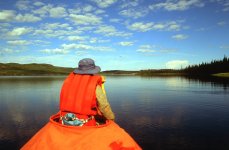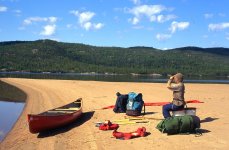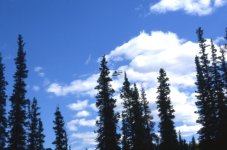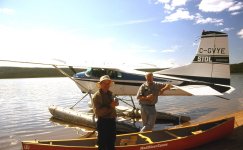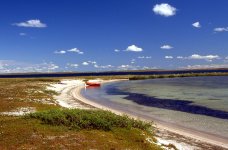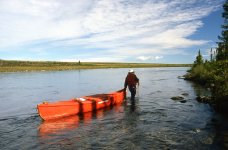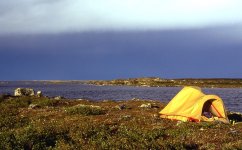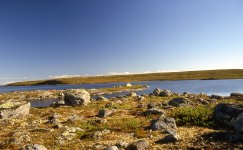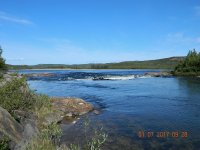- Joined
- Aug 21, 2018
- Messages
- 1,805
- Reaction score
- 2,219
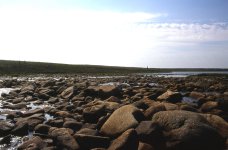
July 17. We rose at 6:00 a.m. to a gentle mist resting on the surrounding tundra ridges. Very comforting. After bannock breakfast and tea, we carried to the water 200 m over some difficult, rocky terrain to the end of the third rapid marked on the 1:250,000 map.
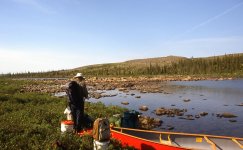
We began our paddling day at 9:00 by heading south, down a small lake with a rocky protrusion on the east shore.
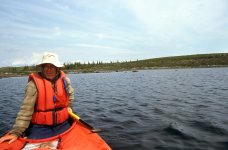
The end of that small lake drained into a very narrow channel that I expected we would be forced to drag or portage.

Surprisingly, however, we half ran/half lined down this channel and then paddled nearly another 1 km (0.6 miles) through a couple of rapids.
We arrived at the section indicated on the topographic map as "indeterminate." The river was indicated by dotted lines. Kathleen and I now faced our longest portage on the Snowdrift River—a real portage of about 400 m (yards) to the beginning of a 3-km (1.5 miles) string of larger lakes. The first of these lakes drained into the second through a 100-m chute, which we dragged. The last of these lakes ended in a thin arm on the east side, from which we lined and dragged, quite easily, about 150 m (yards) to a small hourglass-shaped lake. I say quite easily because there was almost enough water to run. At the end of this lake, though, the water completely disappeared into rocks at the lake’s outlet. We began our carry to camp of about 200 m (yards) at 2:30 p.m. Not a real portage, though. Just a carry to camp.
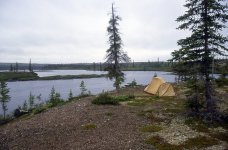
We were camped on the right bank, in a lovely, open, boreal forest. Dry and quiet. We had enjoyed transitioning into the boreal forest and seeing again some of its common plants, such as Twinflower and Fireweed. The scientific name of Twinflower is Linnaea borealis. Borealis because it is so common in the circumpolar boreal forest. And Linnaea in honour of Carl Linnaeus, who created the binomial taxonomic system for naming plants and animals. Twinflower was apparently Linnaeus’ favourite plant.
Toward the end of today’s paddle, we approached a moose feeding along the shore, and minutes later a pair of Greater Yellowlegs chased us, very noisily, from their nesting territory. We were camped only 2 km (1.2 miles) away from permanent water. Only 2 km remained in Tundra Tom's 10-km portage. Looking at the topographic map, I expected, at most, there was only one more kilometre of portaging. Maybe we would get lucky and wouldn’t have to portage at all. I doubted it, though. I expected we would be on the true portage trail tomorrow. About the same difficulty as today. But after that, the most demanding portion of our journey would be over. Should be a gentle journey then.
July 18 . Up at 7:00 a.m. in a low, grey drizzle. On the water at 9:30. We paddled down a small lake and ran the 300-m (yards) chute leading to the first of two very small lakes. The short chute to the second of the small lakes, just above the fourth rapid marked on the 1:250,000 map, was completely clogged with rocks. We beached on river right to scout “Rapid Number 4.” Un-runnable. Un-draggable. We scouted on the right bank all the way to what appeared on the topographic map to be “permanently flowing water.”
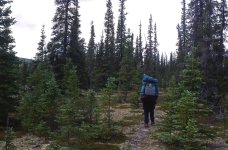
We eventually found a pretty nice trail through open forest. Our route cut off most of the slight bend and avoided the large boulders and rocks near the river.
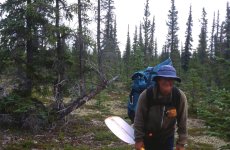
We began our 1-km portage at 10:45 and finished at 12:30 just below the last “wide” section above the anticipated “permanently flowing water.” We leapfrogged our gear along the trail, which went reasonably well for two reasons. First, we didn't lose any gear, and secondly because Kathleen never once uttered the dreaded words "I thought you said this was going to be an easy trip."
From the sardonic look on her face, though, I assumed she was thinking it much of the time.
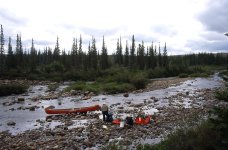
After lunch, just past the end of the fourth marked rapid, we lowered our boat and gear down a 2-m cliff, which was the easiest and shortest access back to the river. That launching spot, however, was too shallow to paddle or line down to the beginning of a short gravel bar, beyond which lay runnable water.
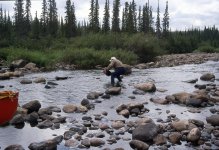
“If only just a few of those rocks weren't in the way, Michael. We might have deep enough water to drag down to that gravel bar.”
“That’s a great idea. Why didn’t I think of that?” I eagerly jumped into the shallow water and tossed aside 7 or 8 rocks.
We then dragged our loaded canoe 50 m (yards) to the gravel bar, lifted over a few canoe lengths, and ran, what I believed, was the final 75 m (yards) of Tundra Tom’s dreaded 10-km portage.
Note that we lifted over the gravel bar. As I explained to Kathleen, a lift over is not really a portage, which requires that you actually carry your canoe and gear a significant distance. Kathleen looked skeptical. Her argument went something like this: “But I thought you said a portage is when you unload the canoe, carry all your stuff, load the canoe and then paddle away.”
Hey. I don't make the rules. I just explain them. For example, if you drove your van to the water’s edge and then carried your canoe and gear a few metres to the river, would you call that a portage? Of course not. I wouldn’t either. It therefore follows that what Kathleen and I had just done was not a portage. It was a lift over.
At 2:00 p.m we had spent 4.5 hours on the water. Since leaving Sandy Lake, we had spent a total of about 15.5 hours “on the water,” including lunches, breaks, scouting, paddling, dragging, carrying to and from camp, lifting over, and portaging. Tom didn’t point out or mention where his portage ended, but we had gone about 10 km, maybe a little bit more, since leaving Sandy Lake. Also, based on the topographic map, I believed that the hardest portion of our journey was now over. We certainly didn’t endure a full 10 km of portaging, but quite of bit of work, nevertheless.
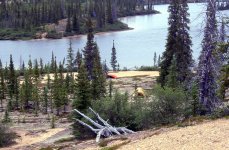
We then easily paddled 3−4 km (2-3 miles) to a very pretty lake and set up camp at 3:00 p.m. on a gentle slope clothed with open forest. After a chili supper, Kathleen and I lay in our tent, relaxing and sipping tea. We were definitely back in the boreal forest now. Today we saw American Robins, Gray Jays (also known as Canada Jays and Whiskey Jacks), four moose (1 male and 1 female with two calves), and one Tundra Swan. Red squirrels scolded us from treetops.
This un-named lake is likely where most Snowdrift River paddlers put in, including Tundra Tom's clients who arrived here 7 days ago, by float plane.
We were only about 10 km(six miles) behind schedule, and we intended to take a layover day tomorrow—laundry, fishing, and strolling. Let the gentle journey truly begin.
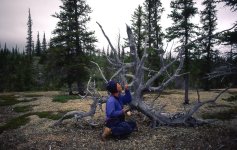
July 19. We slept very well and rose at 8:00 a.m., already feeling much refreshed and renewed. I set up a clothesline, made breakfast, and hauled water and wood while Kathleen did the laundry.
The tree line has shifted over the years, and was 150 to 250 km (90-155 miles) further north as recently as 9,000 years ago in the western arctic and 3,000 years ago in the eastern arctic. Some stands of spruce beyond current tree line are actually remnants of a warmer time, and can not replace themselves from new seed if these small groves are lost to disturbances such as fire.
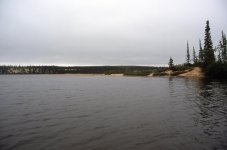
The day remained grey, misty, and windy. We returned to the tent at noon to doze and relax. Up at 3:30 for a brief, unsuccessful fishing attempt in the very shallow water next to shore. No bites except from scores of frenzied mosquitoes. A Least Sandpiper wandered up to within 2 m.
After a quick supper, we organized gear for our descent down the Snowdrift River tomorrow. We hoped to reach Ed Struzik’s “Waterfall Rapid,” about 27 km (16 miles) away. But we'll see what we feel like. Maybe we wouldn’t go that far.
Our laundry never completely dried, despite hanging on the line for 5 hours. Today’s strong northeast wind carried a great deal of mist. To the tent at 7:00 p.m. We anticipated an early start. We were ready to resume paddling.
One of the most enjoyable parts of the day occurred during supper, when two Common Loons performed their mating dance. They repeatedly rose up, flapped their wings, plunged downward, and then glided with heads along the surface of the water, like Northern Shovelers.
.

